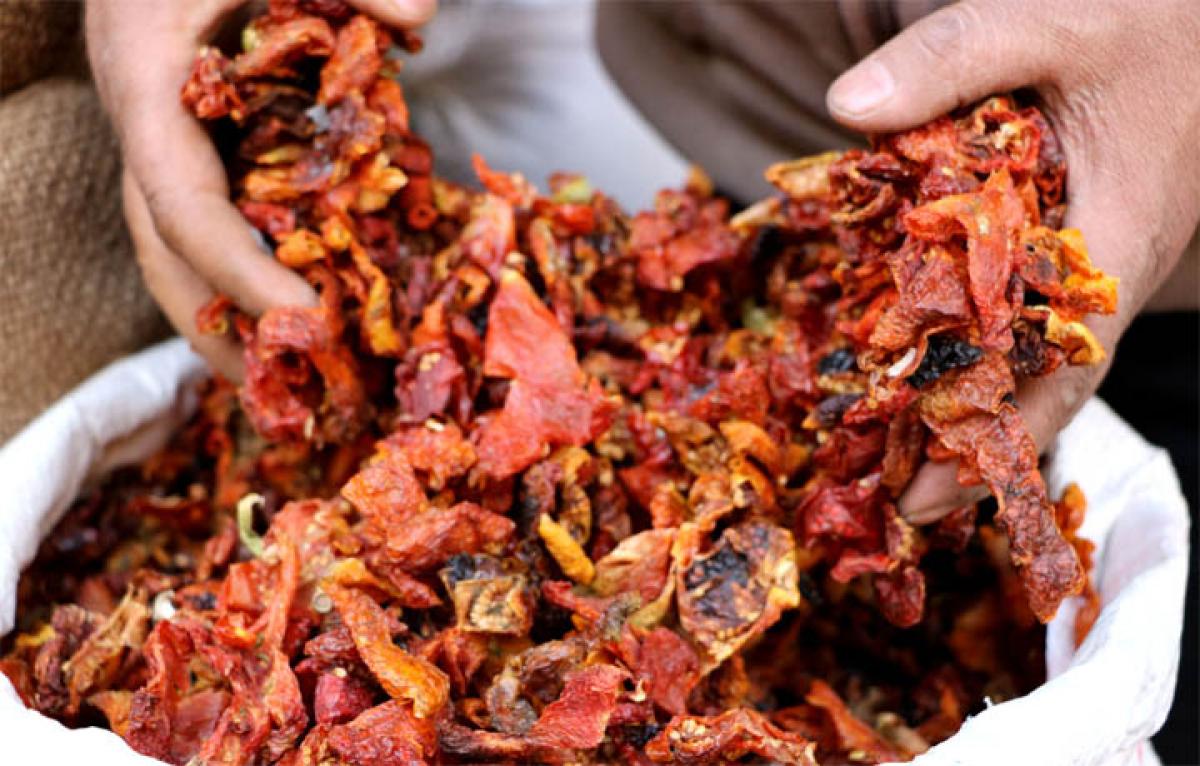Live
- TGCHE looks for a 360-degree ‘Look-in-India’ model
- High priority to strategic partnership with Nigeria
- TG govt scraps road tax, registration fee on EVs
- India test fires ‘un-interceptable’ cruise missile
- ‘Antharanga Veekshanam’ book released
- Manipur burns
- Red Cross to open new blood centre today
- Employability skills programme concludes
- Govt plans to establish offshore Johns Hopkins University Campus in India
- Goa Aces clinch Indian Racing League title
Just In

x
Highlights
Despite changes brought in by middle-class affluence in Kashmir, modular kitchens, microwave ovens, frozen foods and hi-end eateries become redundant in the winter months and nudge the locals back to what was handed down to them by forefathers as heritage - the traditional winter cuisine.
Despite changes brought in by middle-class affluence in Kashmir, modular kitchens, microwave ovens, frozen foods and hi-end eateries become redundant in the winter months and nudge the locals back to what was handed down to them by forefathers as heritage - the traditional winter cuisine.

Doctors and dietitians might cry hoarse about the 'harmful effects' of dried vegetables, dried and smoked fish and dried wild mushrooms, but practice and experience have taught Kashmiris that their past generations lived a healthier, better and cheerful life because they looked within and not outside the landlocked Valley during the harsh winter months to keep body and soul together.
"The first and foremost problem with frozen foods including chicken, mutton and vegetables is that once thawed, it has to be consumed in one go. The first casualty of winter in Kashmir is electricity and without electricity, all your so-called modern kitchen gadgetry becomes junk.

"You might afford to buy frozen food from the market when shortages of mutton, chicken and fresh vegetables hits the Valley, but how do you store it and where? Your fridge is useless in the absence of electricity and this is true of most of your modular kitchen showpiece gadgetry as I call it," Sheikh Bilal Ahmed, a senior agricultural scientist, told IANS.
This is probably the reason the local markets in Srinagar city and other major towns of the Valley are selling dried vegetables including tomatoes, brinjals, bitter gourd, lotus stems, wild mushrooms, turnips and, of course, the delicacies of the more affluent locals like dried and smoked fish.

Masood Kant, 67, a resident of old Srinagar, said: "We also had dried vegetables called, 'rantasi toop' and 'vatis naate'. The former was turnip tops dried and knotted like the plaited hair of a woman. The latter was small dried turnip peelings, including the top green leaves."
Hawkers carrying dried vegetables move in most old city and some uptown areas of Srinagar selling their stuff as a lot of haggling goes on between the sellers and buyers over something the state consumer affairs and public distribution department (CAPD) never thought of fixing prices on.
Even fruits like pears are dried and cooked during the winter months. Kashmiri children, however, like dried pear slices called 'tang hache' raw and eat them like normal fruits.
When cooking gas and kerosene oil shortages hit the Valley - this invariably happens each time the Jammu-Srinagar national highway gets closed due to landslides and snowfall - many rural houses revert to firewood light traditional hearths.
"It is better to return to tradition than queue up in bone freezing temperatures for a cylinder of LPG when chances are nine out of 10 that you will return empty-handed," said Noor Muhammad Wani, a resident of north Kashmir's Safapora village.
Many rural homes still have their small poultries and those living closer to water bodies have small flocks of ducks and swans.
The magic of the 'shab deg' still brings back excitement and thrill among the older generations of Kashmiris.
Shab deg is a special highly-spicy dish of the fattest rooster cooked in a dough-sealed nickel-plated copper vessel with turnips over the simmering fire of the hearth.
"The careful removal of feathers after the rooster is killed is something not everybody knew in the family. This job was, therefore, entrusted to father while mother selected cardamoms, a couple of cloves, turmeric, fennel seeds, chilies, a dash of local saffron and mustard oil," said Ghulam Nabi, a retired school teacher who invoked Allah's blessings for his parents, both of whom have passed away.
"After removing the hard outer scalings of turnips, the full-skin rooster, cut into manageable pieces, is cooked in a dough-sealed vessel over simmering firewood heat on an earthen hearth. The cooking process would continue for the entire night and you know how long winter nights are in Kashmir", Nabi added.
Lunch the next day was a treat which the family would remember for months, according to the retired teacher.
With the winter chill lashing and tossing dried and fallen leaves outside, all members of the family would gather around mother who would first serve cooked rice to each member of the family and then remove the lid from the shab deg vessel.
"By God, the small kitchen, which had an eating place close to the hearth to ensure that food did not get cold as it is served, would get filled with mouth-watering aroma of the dish.
"Today, people have neither the time nor the expertise in cities to cook the shab deg, but some tradition-loving families still do this once in a while to keep alive the tradition," said Nabi, who also spoke of smoked fish, dried fish, dried vegetables and the like that are still part of Kashmir's traditional cuisine.

Next Story
More Stories
ADVERTISEMENT
© 2024 Hyderabad Media House Limited/The Hans India. All rights reserved. Powered by hocalwire.com







